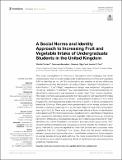Files in this item
A social norms and identity approach to increasing fruit and vegetable intake of undergraduate students in the United Kingdom
Item metadata
| dc.contributor.author | Fischera, Wanda | |
| dc.contributor.author | van Beusekom, Mara | |
| dc.contributor.author | Higgs, Suzanne | |
| dc.contributor.author | Cecil, Joanne | |
| dc.date.accessioned | 2022-05-17T10:30:18Z | |
| dc.date.available | 2022-05-17T10:30:18Z | |
| dc.date.issued | 2022-05-17 | |
| dc.identifier | 277180531 | |
| dc.identifier | 9e933a86-f657-4e78-a6d2-8b890d97e07b | |
| dc.identifier | 85131528958 | |
| dc.identifier | 000804112300001 | |
| dc.identifier.citation | Fischera , W , van Beusekom , M , Higgs , S & Cecil , J 2022 , ' A social norms and identity approach to increasing fruit and vegetable intake of undergraduate students in the United Kingdom ' , Frontiers in Psychology , vol. 13 , 838394 . https://doi.org/10.3389/fpsyg.2022.838394 | en |
| dc.identifier.issn | 1664-1078 | |
| dc.identifier.other | ORCID: /0000-0003-4779-6037/work/113398918 | |
| dc.identifier.other | ORCID: /0000-0002-4536-0558/work/113399089 | |
| dc.identifier.uri | https://hdl.handle.net/10023/25387 | |
| dc.description | Funding: The funding for open access was supported by the University of St Andrews. | en |
| dc.description.abstract | This study investigated the influence of descriptive norm messages that either communicated that university students eat a sufficient amount of fruit and vegetable (F&V) or that they do not, on F&V consumption, and whether or not any effects are moderated by student identification. An online 2 (Norm: ‘Sufficient’/‘Insufficient’) x 2 (Identification: ‘Low’/‘High’) experimental design was employed. Infographics containing ‘sufficient’/‘insufficient’ F&V intake descriptive norms were presented. An identification manipulation was employed to create ‘high’/‘low’ student identifiers. F&V intake intentions were assessed after the manipulations; self-reported F&V intake was reported at 2 days post-intervention. UK undergraduate students (N=180) reported intake intentions, of which 112 (62%) completed the behavioral follow-up. Participants were predominantly white female students from Scottish universities, mean age 20.4 (±1.6) years. Baseline mean F&V consumption was high (4.5±2.8). There were no significant main effects of Norm or Identification manipulations on F&V intentions and intake. Significant norm×identification interactions were revealed for fruit intake intentions and vegetable intake at follow-up, indicating half portion differences (~40g) between groups. Ironic effects were observed for ‘high’ identifiers, who neither intended to, nor acted in accordance with group norms; ‘low’ student identifiers intended to and followed group norms, whereby the ‘sufficient’/‘low’ group intended to consume significantly more fruit portions, and consumed more vegetables than the ‘insufficient’/‘low’ group. Given the half-portion differences between groups resulting from the norm×identification interactions, future research on a larger sample of young adults with low F&V intake is warranted to further explore the conditions under which moderating effects of identification are observed and the underlying mechanisms. | |
| dc.format.extent | 13 | |
| dc.format.extent | 2197627 | |
| dc.language.iso | eng | |
| dc.relation.ispartof | Frontiers in Psychology | en |
| dc.subject | Fruit intake | en |
| dc.subject | Social norm | en |
| dc.subject | Descriptive norm | en |
| dc.subject | Eating norms | en |
| dc.subject | Student identification | en |
| dc.subject | Identity strength | en |
| dc.subject | Fruit & vegetable intake | en |
| dc.subject | BF Psychology | en |
| dc.subject | NDAS | en |
| dc.subject | MCC | en |
| dc.subject.lcc | BF | en |
| dc.title | A social norms and identity approach to increasing fruit and vegetable intake of undergraduate students in the United Kingdom | en |
| dc.type | Journal article | en |
| dc.contributor.institution | University of St Andrews. School of Medicine | en |
| dc.contributor.institution | University of St Andrews. Population and Behavioural Science Division | en |
| dc.contributor.institution | University of St Andrews. Health Psychology | en |
| dc.identifier.doi | https://doi.org/10.3389/fpsyg.2022.838394 | |
| dc.description.status | Peer reviewed | en |
This item appears in the following Collection(s)
Items in the St Andrews Research Repository are protected by copyright, with all rights reserved, unless otherwise indicated.

